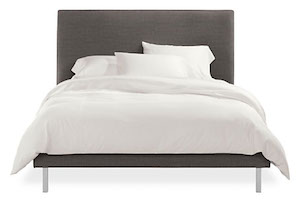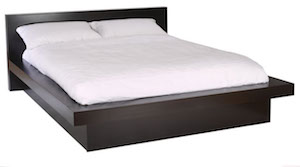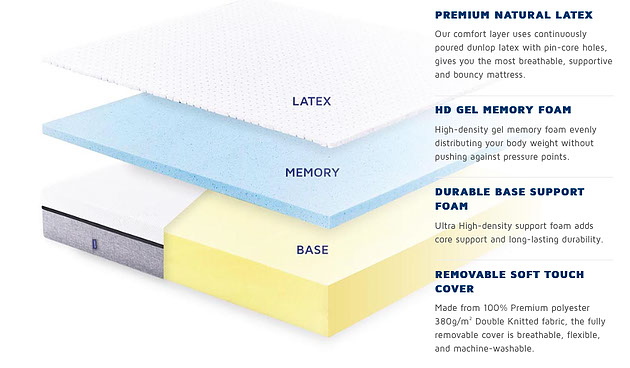There are many different types of beds that include the following:
- Innerspring Mattress.
- Hybrid Mattress.
- Waterbed.
- Foam Mattress.
- Gel Mattress.
- Air Bed.
- Memory Foam (Visco) Mattress.
- Latex Mattresses
- Futon
- Adjustable foundations


Innerspring Mattress
An innerspring mattress uses a steel coil support system. Manufacturers offer several different types of spring systems, including units with springs connected into a single unit and individually wrapped pocketed coils. Spring shapes, designs, coil gauge, and number of coils in a mattress can vary. The innerspring is covered by padding or upholstery materials, which can include various foams, fiber, and additional layers of smaller steel springs. Coil count can be more arbitrary, but the idea is that the greater the number of coils, the more points of support and greater distribution, thus the better the bed can contour and support the sleeper.
Hybrid Mattress
A hybrid mattress often combines either a steel coil support system with one or more types of foam, such as polyurethane foam, memory (or visco elastic) foam, or latex foam, etc. or the hybrid matress can also combine latex with several other types of foam including memory foam.
Waterbeds
Waterbeds use a water chamber as the support system. Manufacturers offer two types of waterbeds: hard-sided and soft-sided beds. A hard-sided waterbed consists of a water chamber inside a rectangular wood frame. A soft-sided waterbed consists of a water chamber inside a rectangular frame of rigid foam, zippered inside a fabric casing. The water chamber is covered by padding or upholstery materials, which can include with various foams and fiber. Both types of beds usually rest on top of a platform. Waterbeds are designed to look like a conventional bed and fit existing bedroom furniture. The water chamber can be “free flow” (in which nothing obstructs the flow of water within the mattress) or “waveless” (in which fiber or baffles limit the water’s motion).
Foam Mattress
Foam mattresses use one or more types of foam as the support system. The foam may be polyurethane foam, memory (or visco elastic) foam, or latex foam, and can contain gel or other materials. The foam used in such mattresses can be manufactured in a variety of shapes and densities to offer consumers a mattress that has different comfort, feel and heat dissipation features.
Gel Mattress
Gel mattresses use a type of foam that contains gel in the product’s support system, upholstery layers, or both. The gel is added to the foam using deferent types of technology. The gel foam can offer consumers different comfort, feel and heat dissipation features.
Airbeds
Air beds use an adjustable air chamber as the support system. Unlike the type of air mattresses used for camping, the air chamber of a residential air bed is covered by padding or upholstery materials, which can include various foams and fiber. Air beds allow you to adjust the firmness, and usually allow each side of the bed to be controlled separately in order to meet the individual and changing needs of couples. Air beds are designed to look like a conventional bed.
Memory Foam
Memory foam (or visco elastic foam) mattresses use a high density polyurethane foam as the support system, in the upholstery layer, or both. This foam has properties that allow it to contour closely to the shape of the sleeper.
Latex Mattress
Latex mattresses use latex foam as the support system, in the upholstery layers, or both. Latex may be made from plant or petroleum-based materials.
Futon
Unlike a stationary foundation or box-spring, an adjustable foundation allows you to bend, elevate or lower various parts of the sleep surface. Many adjustable foundations have dual controls that each partner can use to adjust the sleep surface elevation to meet their individual needs. Most adjustable foundations are powered by an electric motor, but some are manually adjusted. They are designed to look like a conventional foundation when placed in the fully horizontal position. For best results, adjustable foundations should be used with a mattress designed for that purpose.
There are other types of mattresses but this list covers the majority of the most common mattresses.
Important Facts and Precautions:
The average mattress is a cocktail of toxic substances however just because a mattress is called organic does not mean that it’s non-toxic. 100% organic mattresses simply do not exist. In reality, any mattress company claiming to have organic mattresses actually contains a mix of both organic materials and other natural components in their mattresses. As a result there may be needed a period of off-gassing before you start to use your mattress.
The innerspring mattress has additional problems where the steel coil may act as a conductor for an electromagnetic radiation from household appliances such as the television, computers, cellar phones, WiFi routers and even dirty electricity from the power outlets themselves. In addition the innerspring mattress may also become magnetized which adds additional dangers.
In the United States and many other countries bed frames and box springs are made of metal, and the length of a bed is exactly half the wavelength of FM and TV transmissions. The maximum strength of the field develops 75 centimeters above the mattress, so when sleeping on your right side, your left side will be exposed to the highest field strength. This adds to the already amplification of electromagnetic radiation from an innerspring mattress.
Selection the best mattress
There is no such thing as the best mattress however there are some that are superior to others. Some of the points comes down to personal comfort but its also important that with that comfort comes hidden dangers mentioned above.

